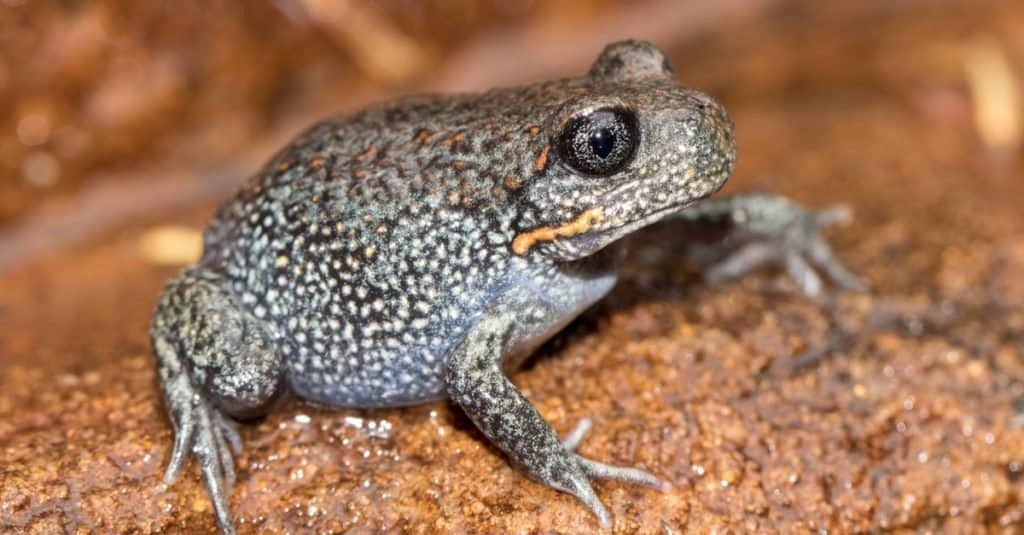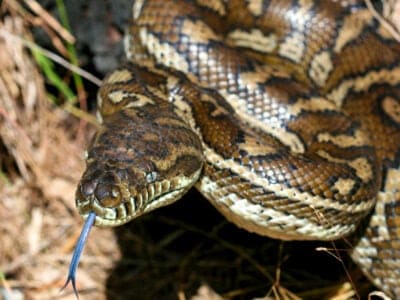Burrowing Frog
.jumbotron {
background-image: url(“https://a-z-animals.com/media/2019/11/Burrowing-frog-header-400×300.jpg”);
}
}
@media only screen and (min-width: 641px) and (max-width: 920px) {
.jumbotron {
background-image: url(“https://a-z-animals.com/media/2019/11/Burrowing-frog-header-470×370.jpg”);
}
}
@media only screen and (min-width: 921px) {
.jumbotron {
background-image: url(“https://a-z-animals.com/media/2019/11/Burrowing-frog-header.jpg”);
}
}
Burrowing Frog
Found close to marshes, streams and lakes!
Burrowing Frog Scientific Classification
Read our Complete Guide to Classification of Animals.
Burrowing Frog Conservation Status
Burrowing Frog Facts
- Lifestyle
-
- Solitary
- Favorite Food
- Insects
- Type
- Amphibian
- Average Clutch Size
- 200
- Slogan
- Found close to marshes, streams and lakes!
This post may contain affiliate links to our partners like Chewy, Amazon, and others. Purchasing through these helps us further the A-Z Animals mission to educate about the world’s species..

Spiders that fly! Fish that walk! And 1000+ more incredible animals. Discover them all for FREE
.photo-gallery {
–margin: 0px auto 0px;
–padding: 0px 0px 0px 0px;
}
.gallery-link {
background-image: url(“https://a-z-animals.com/media/2019/11/Burrowing-frog-Ornate-1024×535.jpg”);
background-repeat: no-repeat;
background-size: cover;
background-position: center;
height: 500px;
justify-content: center;
text-align: center;
align-items: center;
display: flex;
border: 2px solid #000;
}
.gallery-link img {
height: 50%;
}
@media only screen and (max-width: 768px) {
.gallery-link {
height: 300px !important;
}
}
View all of the Burrowing Frog images!
“Some burrowing frogs can spend their entire lives underground!”
Burrowing frogs are amphibians that dig themselves into the ground, and they can remain there for extremely long periods of time. They possess muscular arms and legs to aid in digging, and they make their homes near slow-moving, almost stagnant bodies of water. Eastern owl frogs have a soft hooting call that is commonly mistaken for that of an owl. Habitat loss is a major cause for concern, and it threatens the vast majority of burrowing frog species.
5 Incredible Burrowing Frog Facts!
- The giant burrowing frog is so elusive that scientists have been unable to measure its population size.
- Burrowing frogs’ extremely muscular arms and non-webbed feet are specifically adapted to enable them to dig their burrows into the ground.
- The eastern owl frog, moaning frog, and the whooping frog are all species of burrowing frogs in Australia that make unique and identifiable sounds.
- Giant burrowing frog eggs can remain dormant for months after being laid in burrows until flooding, rainwater, or tidal water enters the burrow and carries them out to larger pools.
- Eastern owl frogs live for upwards of 10 years, and some have been recorded surviving for up to 15 years.
Burrowing Frog Scientific Name
The giant burrowing frog’s scientific name is Heleioporus australiacus. It is also known as the eastern owl frog or the giant burrowing frog, and it is a near relative to the blunt-headed burrowing frog. The genus Heleioporus contains six species of frogs all of which are burrowing frogs native to the continent of Australia. Eastern owl frogs are the only species that reside in South East Australia while the other five live in the South West. The giant burrowing frog is a member of the family Limnodynastidae and the class Animalia.
The other frogs of the Heleioporus genus are the western spotted frog (H. albopunctatus), the hooting frog (H. barycragus), the moaning frog (H. eyrei), the whooping frog (H. inornatus), and the sand frog (H. psammophilus). As you can see from the common names given to these different species, the sounds that they make are distinct enough to identify some of the various species by that trait alone.
Burrowing Frog Appearance and Behavior
The eastern owl frog is one of the largest frogs to call Australia home. There are several facts that you can rely on to properly and quickly identify an eastern owl frog from the other native frog species. They can be up to three to four inches in length with a rough, warty, and multicolored back, a smooth single light-colored belly, and non-webbed feet. They have vertical pupils, and their backs may be spotted as well. The frog’s forelegs are noticeably muscular to aid in their digging through soil and other ground covering debris. The lack of webbing on their feet is an adaptation that makes it easier to dig.
The males possess large black spines on their chests and arms that aid in holding their partner still for mating. Both males and females will dig burrows by backing into them as they use their hind legs and feet to throw dirt from the hole. The eastern owl frog earned its name from the soft, hooting sound that the male makes from the mouth of the burrow while trying to attract a mate. The call is very similar in nature to that of an owl. This call can be heard year-round, but it is much more prevalent during mating season.
The vast majority of their lives are spent underground, and this has prevented any significant study of their population outside of chance encounters and strictly designed trapping methods. They are the most active during the summer months into the fall, and these frogs are most likely to be observed during and after heavy rainfall or thunderstorms. They conceal themselves on the banks of rivers and other water bodies, and they use vegetation and their burrows to conceal themselves from sight.

Ken Griffiths/Shutterstock.com
Burrowing Frog Habitat
The giant burrowing frog will reside in many different potential habitats. From wet forests to stream lands, the frog will always make its burrow in an area that is located near a significant water source that is slow-moving. These burrows frequently take advantage of natural features of the landscape such as cracks, crevices, and runoffs to capture slow-flowing water for reproduction.
Burrowing Frog Diet
The giant burrowing frog’s diet is that of a generalist. It will eat many different types of foods, but it is a carnivore that only consumes other animals.
What eats the burrowing frog?
Predators for the eastern owl frog are the same for most other frogs. Foxes, snakes, lizards, and birds all prey upon burrowing frogs.
What does the burrowing frog eat?
The burrowing frog primarily consumes invertebrates like scorpions, spiders, ants, and centipedes. It uses its long tongue to catch and eat its prey.
Burrowing Frog Predators and Threats
The primary predatory threats to the eastern owl frog are ambush predators like the above-listed foxes, snakes, and birds. All of these animals target the burrowing frog in a similar manner. They lay in wait for an opportune moment to strike at unsuspecting prey.
The other major threats to the giant burrowing frog are man-made. Loss of habitat due to myriad types of construction like residential, commercial, utility, railroad, and others are wreaking havoc on the habitat for this frog. Fire prevention and suppression methods used to combat the brush fires common to the native habitat of the burrowing frog also take a significant toll on their population. Finally, pollution is yet another major threat to the species; there have been no scientifically observed cases of the eastern owl frog reproducing in an even slightly polluted water source.
A lack of clean, fresh water for mating and reproduction will further add challenges to the success of this animal. Furthermore, drought conditions experienced in regions previously known for an abundance of freshwater further limit locations available for mating. For all of these reasons, the giant burrowing frog is listed as a vulnerable species on the IUCN Red List; however, the other species within the Heleioporus genus are considered to be of least concern.
Burrowing Frog Reproduction, Babies, and Lifespan
The breeding season begins in the fall, and the males call out with their hooting mating sounds from within the burrow or out in the open. Males are extremely territorial during mating season, and they average a claimed area of 0.04 hectares that will not overlap with the claimed area of another male. The female eastern owl lays her eggs in a foamy substance inside the burrow or in the water underneath vegetation. There can be anywhere from 800-1,250 eggs, but the average is around 500-800 eggs per female.
The eggs remain dormant until rain or other water flow washes them from their current location into a larger pool of water where tadpole development begins in earnest. Tadpoles take between 12 weeks to a year to fully develop depending on weather conditions and the timing of the season. They are typically a blue-gray color with streaks of black, and giant burrowing frog tadpoles have grown as large as three inches themselves!
Tadpoles that have not fully matured by the time winter arrives will go dormant, and they will resume their development in the spring. Once fully matured, eastern owl frogs live approximately 10-15 years. They are slow growers, and they are considered to be very long-lived for a frog species.
Burrowing Frog Population
The facts are that there are no accurate numbers for the population of Heleioporus australiacus in the wild. Its range is severely limited to Southeastern Australia around the area of New South Wales, and the population is presumed to be in decline because of a striking loss of habitat. This species is considered to be vulnerable.
View all 192 animals that start with B
Burrowing Frog FAQs (Frequently Asked Questions)
Are Burrowing Frogs herbivores, carnivores, or omnivores?
Burrowing frogs are carnivores. They eat other animals, and their primary diet consists of invertebrate species that they capture with their long, sticky tongue.
What Kingdom do Burrowing Frogs belong to?
Burrowing Frogs belong to the Kingdom Animalia.
What class do Burrowing Frogs belong to?
Burrowing Frogs belong to the class Amphibia.
What phylum to Burrowing Frogs belong to?
Burrowing Frogs belong to the phylum Chordata.
What family do Burrowing Frogs belong to?
Burrowing Frogs belong to the family Myobatrachidae.
What order do Burrowing Frogs belong to?
Burrowing Frogs belong to the order Anura.
What genus do Burrowing Frogs belong to?
Burrowing Frogs belong to the genus Heleioporus.
What type of covering do Burrowing Frogs have?
Burrowing Frogs are covered in permeable skin.
In what type of habitat do Burrowing Frogs live?
Burrowing Frogs live in forests, rivers, and marshes.
What is the main prey for Burrowing Frogs?
Burrowing Frogs prey on insects, worms, and spiders.
What are some predators of Burrowing Frogs?
Predators of Burrowing Frogs include foxes, snakes, and birds.
What are some distinguishing features of Burrowing Frogs?
Burrowing Frogs have long limbs and rough, bumpy skin.
How many eggs do Burrowing Frogs lay?
Burrowing Frogs typically lay 200 eggs.
What is an interesting fact about Burrowing Frogs?
Burrowing Frogs are found close to marshes, streams, and lakes!
What is the lifespan of a Burrowing Frog?
Burrowing Frogs can live for 10 to 15 years.
How fast is a Burrowing Frog?
A Burrowing Frog can travel at speeds of up to 5 miles per hour.
What is the scientific name for the burrowing frog?
The most popular burrowing frogs belong to the genus Heleioporus which also contains several related subspecies; however, the specific animal known as the giant burrowing frog or eastern owl frog is Heleioporus australiacus. These frogs are native to Australia, but burrowing frogs can be found in many countries around the world. The blunt-headed burrowing frog’s scientific name is Glyphoglossus molossus, and it lives in the Oceania region.
How long can a burrowing frog stay underground?
The burrowing frog stays underground for the vast majority of its life. Upwards of 95 percent of the frog’s life is spent outside of breeding areas, and that time outside of breeding areas is spent underground or under the ground cover in the area.
What do burrowing frogs eat?
Eastern owl frogs and their blunt-headed frog cousins eat primarily invertebrates. This includes insects, spiders, centipedes, and scorpions.
Where do burrowing frogs live?
Burrowing frogs live in Southwestern and Southeastern Australia with only the eastern owl frog inhabiting the Southeastern area around New South Wales. They live in burrows or a series of burrows that they dig along riverbanks and shorelines of other water bodies. They prefer slow-moving water or standing pools of water to build their homes near.
How big are burrowing frogs?
Burrowing frogs can grow larger than three and a half inches and are extremely muscular. Their bodies tend to be round due to the sheer quantity of muscle that they possess. Most frogs use this muscle to dig their burrows backward, but the blunt-headed frog actually forces his face through the ground to dig.
How do Burrowing Frogs have babies?
Burrowing Frogs lay eggs.
How to say Burrowing Frog in …
Heleioporus
Burrowing Frog
Heleioporus
Heleioporus
Sources
- Australian Museum, Available here: https://australian.museum/learn/animals/frogs/giant-burrowing-frog/
- Frogs of Australia, Available here: https://www.frogs.org.au/frogs/genus/Heleioporus/
- Giant Burrowing Frog, Available here: https://www.environment.nsw.gov.au/resources/nature/Giantburrowingfrogeia0501.pdf
- Office of Environment & Heritage, Available here: https://www.environment.nsw.gov.au/threatenedspeciesapp/profile.aspx?id=10398

















